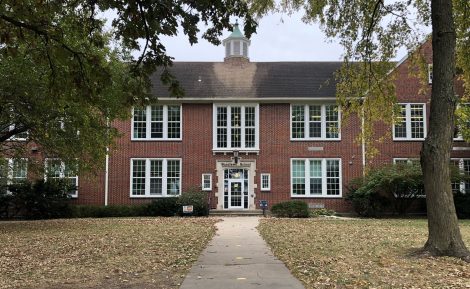Lawrence schools have full agenda for 2011

Gabby Ramos, left, and Kyle Berkley, both South Junior High eighth-graders, play their trombones during band rehearsals Dec. 16. All district eighth-graders will move into high school next year as freshmen become part of the high school campuses and junior highs change into middle schools.
Fifth-graders will be the oldest students in elementary schools.
Sixth- through eighth-graders will be in middle school, following new schedules designed to help ease the transition into secondary education.
And freshmen? They’ll actually be attending classes on high school campuses, instead of seeing their grades simply recorded on high school transcripts.
For Chelsea Sandy, a junior at Lawrence High School, the Lawrence school district’s coming changes for 2011-12 lead to an easy conclusion.
“It’s going to be crowded,” she said.
Sandy may be talking about the hallways, the lockers and the cafeteria, but she could have just as easily been referring to the district’s ongoing list of issues, changes and financial challenges to be addressed.
Here’s a look at some of the major items for the district, as the calendar turns to 2011:
Redesign moves forward
The district is still refining plans for its major redesign and reconfiguration, in the works for more than a year and in the planning stages for months.
Every school in the district will see operational changes: No more sixth-graders in elementary schools, no more ninth-graders in junior highs, and no longer a three-year duration for the on-campus portion of a four-year high school education. The high schools will go from six periods per day to seven periods per day, and their campuses could see some physical modifications — additional lockers, kitchen remodeling, acoustical changes to some rooms — by the time classes begin in August.
Until then, of course, officials will continue planning: developing curriculum, devising schedules, determining personnel shifts.
“We’ll see how that all fits together,” said Frank Harwood, the district’s chief operations officer.
Task force recommendations
The Lawrence Elementary School Vision Task Force has another month to finalize its recommendations for addressing the physical and operational needs of Lawrence elementary schools for years to come.
The task force’s desires — from eliminating portables to fostering “community” schools — are being combined into a single document. The next meeting is at 7 p.m. Jan. 3 at district headquarters, 110 McDonald Drive.
Recommendations will be expected to help members of the Lawrence school board address a mounting list of maintenance needs in schools. The district typically budgets about $4.8 million a year for new furnishings, technology, repairs and other matters in all district schools, but administrators acknowledge that they’ve held off on making many upgrades in elementary schools.
They’ve been waiting to see a written version of what the community envisions for such schools in the years ahead.
“Hopefully the task force recommendations will help us form some better direction, and we’ll move forward,” Harwood said.
Financial uncertainties
Board members cut $4.6 million in spending during the past year, without closing schools. And district officials are preparing — mentally, at least — to deal with another round of financial pressures as the Kansas Legislature reconvenes in January.
“We are hopeful that we will not experience midyear cuts,” said Rick Doll, district superintendent, referring to $3.3 million in mandated cuts that led up to the $4.6 million settled on for 2010-2011. “But we are not optimistic: We do think there will be cuts for next (school) year.”
Harwood has suggested that another $3 million to $4 million in cuts could be on the way. The last time board members needed to make adjustments, they implemented furloughs, cut staff and eliminated programs.
There’s still hope that such changes won’t be necessary this time around. The economy could pick up, covering for the scheduled loss of millions of dollars statewide in federal stimulus funding. Lawmakers could decide to pump more money into education.
Such conditions and decisions will become more clear in the weeks and months ahead.
“With the budget situation, we’re going to have to have close contact with our legislators — especially in Topeka, but also at the federal level,” said Marlene Merrill, in her fourth year on the school board.
Improving achievement
District officials soon will receive a report from the Kansas Learning Network, outlining ways to help improve teaching of reading and math in district schools.
Because of results recorded on state assessment tests, the Lawrence district is required to participate in the program, one devised by the Kansas State Board of Education to help districts identify problem areas and devise solutions.
The district fell short of rising standards for the number of students who scored proficient or better on the standardized tests during the past two years. The scores are used to gauge compliance with the federal No Child Left Behind program, and the district missed targets for students with disabilities.
While 83 percent of the district’s overall student population scored proficient or better, those levels were achieved by only about two-thirds of students with disabilities.
The network’s report will be expected to bolster the district’s ongoing efforts to “increase student achievement, for all students, while closing achievement gaps,” Doll said.







